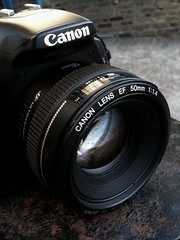
The biggest ‘Oh… Shit’ feeling I’ve ever had on a photo job was when I had a rush-job: Press deadline was at 5pm, and I had to photograph an event at 3pm. The event was meant to last until 4pm, which would give me half an hour journey time back to the office, half an hour of Photoshopping… Tight, but doable. Then the worst thing imaginable happened: The event was delayed in starting, and my time was ticking away.
When I finally got in the taxi on my way back, I decided to clean out all the photos I knew I wasn’t going to use from the memory card, using the camera itself, so I could spend less time downloading and sorting, and more time just fixing it, so we could drop in the images and get the magazine to print.
I selected a batch of photos. “keep that one, lose that one, keep, keep, lose, keep, that’ll do, Format. Yes, of course I want to format. Yes. Confirm.”. I sat back in the cab, mentally going through what I had to do when I made it back to the office. Then it suddenly hit me.. ‘Format?’ Shit! No! Surely not… NOOOO!!!!
Here’s what to do if you are as big a plum as I am…
The first rule of data recovery

If you fear something Bad might have happened, take your memory card out of the camera immediately, and stop using it.
It has happened many of us: that ‘oh, no…’ feeling that occurs when you realise that you have just lost your pictures on your memory card. The good thing is that all is not lost and there are some ways to get that data back. We are going on a mission called ‘saving our asses’ and here is what we will need to make this a successful mission.
Once you have lost data on a memory card you need to quarantine that card and stop using it immediately.
I know I wrote that in bold, but let’s repeat it, because it’s the single most important thing you’ll learn from this article:
If you lose data on a memory card, take it out of your camera, and do not use it for anything else.
You may have to exhaust different options with that card to try to recover those photos so don’t keep adding pictures to it. Continuing to use the card can be detrimental to you actually recovering those photos.
How are images deleted from a card?
Image deletion operations – and, indeed, formatting a card – is normally not what most people think of as ‘proper’ deletion. Instead, you’re merely re-setting the file allocation table. Imagine your memory card as a chest of drawers which has 20 drawers, and can hold 20 photographs. When you take a photo, it’s put into one of the drawers, and you stick a little lable, like IMG_1234.RAW on the front of the drawer. It’s safe there. When you need it, you open the drawer, and you take the picture out.
When you delete a photo, something interesting happens: The photo isn’t removed from the drawer, all your camera does, is to peel the label off the front of the drawer. That means that this drawer is now ‘free space’, so if you had a full set of drawers, and ‘delete’ three photos, you now have 17 full drawers, and three ‘empty’ ones. When you take a new photo, your camera puts the photo into one of the free drawers, on top of the old photo.
Your old photo doesn’t disappear off the memory card until a new photo is put on top of the old one. Even if your card reads ‘empty’, all the old photos are still there, just not easily accessible.
Recovering data from your memory card

I was half-way around the world (Well, 1,400 miles into my motorbike tour of Europe) when I took this photo - while the picture itself isn't that unique, it represents a fond memory for me - I'd be gutted if I had lost it, but I was able to recover it off my memory card. Phew.
Lost data recovery operations happen with some type of third party software, in fact this is probably the method you are going to use to retrieve your data. There is a problem though, which software option should you purchase?
There are literally hundreds of options to choose from in this area, both paid and free choices. It would be close to impossible to tell you exactly which one is the best for you, because the focus of the programs can vary. Depending on how you lost your photos that could determine which product will be best suited to solve your problem. However before you go out and purchase a product make sure you take these steps:
Try a demo version first – Many programs (like the very popular Photo Rescue, which is available for both Mac and Windows) will allow you to use a trial version before you have to purchase a full version. It is strongly recommended that you test the trial version with your camera and with your specific problem: For these types of software, the trial software will usually show you which images could be recovered with the full version of the software.
Leaving it to the professionals

Some photos are less valuable than others - but if yours are a matter of life and death (say, you lost someone's wedding photos), then get professionals involved!
Professional data recovery is many orders of magnitude more expensive than doing it yourself, but it’s incredible what can be recovered…
And if your photos are truly invaluable (losing the photos as a wedding photographer, for example, could prove hideously expensive if you get sued by the couple as a result… Which has been known to happen, and this is why there is separate wedding photography insurance out there), you might have to find a local professional service (try googling for it).
If you have to go down this route, go to the corner shop and buy some beans and toast off the internet, because if you have to get someone to manually pick the card apart and read the chips inside your card directly, you’d not going to be able to afford to eat anything else anytime soon – I once helped someone find a data recovery service, and they paid over £3,500 to get a dead hard-drive resuscitated for long enough to copy it over to a fresh drive. On that note – when did you last back-up your photos?
Do you enjoy a smattering of random photography links? Well, squire, I welcome thee to join me on Twitter - Follow @Photocritic
© Kamps Consulting Ltd. This article is licenced for use on Pixiq only. Please do not reproduce wholly or in part without a license. More info.
